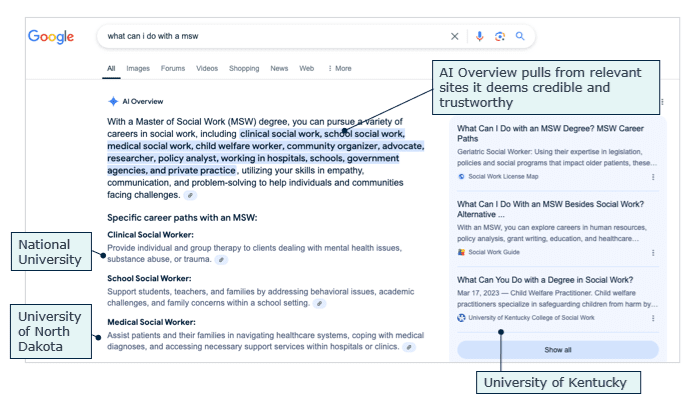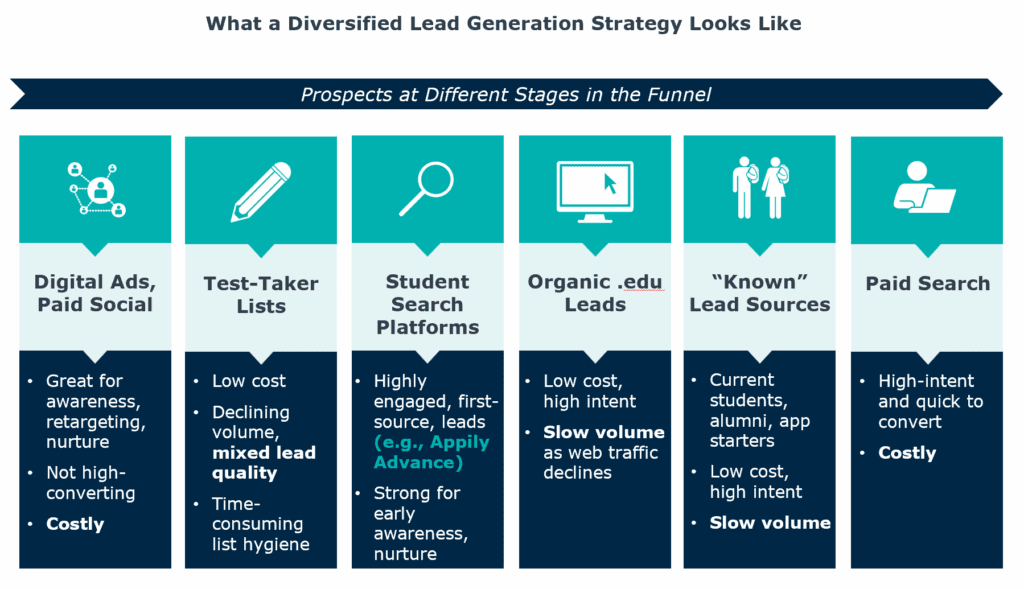Why AI is the biggest disruption to your graduate lead pipeline
The way students search for graduate and adult-serving programs has shifted dramatically in just a few years. AI engines such as ChatGPT and Claude are the new entry points to search. Traditional search engine optimization (SEO), once a reliable source of leads, no longer guarantees clicks as students get answers to their questions directly in search results. Even paid search isn’t a sure bet anymore as costs-per-click (CPC) rise exponentially and clicks fall when AI Overviews are present.
This shift means once effective acquisition strategies are delivering less value. And graduate marketers need new ways to ensure a steady pipeline.
In this blog, I’ll share two ways AI search impacts graduate and adult lead generation, with action steps to stay ahead in an increasingly competitive digital landscape.
2 key ways AI search impacts graduate and adult lead generation
1. AI is replacing traditional search engines as the starting point for online searches
Gen Z is driving a rapid shift in search, with 34% reporting they turn to AI chatbots for informational searches. In a recent survey of over 8,000 prospective and current adult learners, nearly 20% said they use AI in their search process (a 15% increase over last year). This behavior is reshaping how students discover programs, but many graduate lead generation strategies still hinge on traditional search engine visibility (organic and paid search listings). Now, your visibility also depends on how (and if) your programs are appearing in answer engines such as ChatGPT, Claude, or Perplexity. If they’re not, you’re losing prospective leads who are using these resources to build their short-list of programs.
In an attempt to keep pace with AI platforms, traditional search engines like Google are also adapting to AI. Even if a student heads to Google to search for programs, AI Overviews, affectionately called position “zero,” appear on 55% of searches. This crowds out both paid and organic listings and has caused a stomach-turning 60+% decline in click-through rates (CTR), on average—even among listings ranked in positions 1-3. When fewer students click, fewer become leads or inquiries and your pipeline contracts.

Takeaway: AI visibility is a new KPI to measure and optimize for.
Action Plan: Run an AI visibility audit (or ask us to run one for you) so you can understand how your institution and programs appear in AI engines and ways to improve. Our research shows this is a significant opportunity area: in a recent survey of 120+ higher ed marketing leaders, 60% reported they’d researched tools to adapt to AI search. But only one-third audited their strategy in the past year. Most are likely still underutilizing AI optimization best practices, putting their top of funnel at risk.
2. AI is reshaping how paid search and SEO drive leads
SEO and paid search continue to drive leads but not at the guaranteed volumes or as efficiently as in prior years. Here are some of the factors at play:
- Graduate students value—and act on—organic search results: EAB’s 2025 Adult Learner Survey found that 40.5% of users click on organic (non-ad) links when searching for information on a program. And we know from serving 200+ partners that visitors from organic search have higher application and engagement rates than many other lead sources.
- Marketers have long relied on paid search, but it’s becoming harder to sustain: Higher ed marketers still rank paid search among the top three most effective sources of high-intent leads, yet engagement is falling and rising media costs are driving cost-per-lead up. In the same survey I mentioned above, only 6.5% of respondents reported clicking on paid or sponsored links when searching for colleges, compared to 23% who said they read AI-generated summaries at the top of the page.
Takeaway: AI is shaking up some of the most trusted lead generation sources higher ed marketers have relied on for years. While it’s not replacing them yet, it’s forcing savvy enrollment leaders to rethink their lead generation strategy.
Action Plan: Understand where your leads come from and ensure no more than 50-60% of your leads come from a single lead source (more on lead diversification strategies below!).
2 ways to future-proof your lead gen strategy
1. Make sure you have a diversified lead generation strategy
While organic and paid search strategies are essential, the trick to expanding your top-of-funnel reach is to not focus too heavily on any single lead gen source. But with fewer traditional sources, declining organic traffic as AI reshapes search, and rising ad costs, many schools are struggling to expand their top of the funnel. Highly engaged, first-source lead generation solutions such as Appily Advance offer a reliable pipeline of prospective students whose interest has already been validated.
Beyond smart sources such as Appily Advance, enrollment teams need a diversified lead generation strategy to improve reach and lead quality.
What is a “diversified lead generation strategy”?
A diversified lead generation strategy draws from multiple sources at every stage of the funnel. To maintain a high volume of the right leads, focus on curating a balanced mix of sources. In the graphic below, we provide an overview of diverse lead sources, including organic sources such as SEO, paid ads, student search platforms, and “known” lead sources. Known sources include audiences like current students, alumni, and application starters.

Diversification doesn’t just mean more channels. It also means making sure your lead sources are reliable and pre-validated, alongside organic and paid strategies.
2. Keep your content strategy competitive: Optimize for AI search
Strong keyword strategy still matters, but it’s no longer enough on its own. Today, optimizing your content strategy means ensuring every page—especially program and enrollment-focused ones—reflects how students naturally search. AI platforms prioritize conversational, specific queries that mirror how students naturally ask questions, such as “What are the best part-time master’s programs in data science that I can complete online while working full-time, and how much do they usually cost?’”
Institutions should continue to align their content with these long-tail, intent-driven searches, but recognize that even well-crafted pages may not guarantee clicks or conversions. That’s why keyword work should be paired with reliable, high-quality lead sources to ensure visibility translates into actual students in your funnel.
To ensure your content (and keyword) strategy is optimized for search, adopt the following strategies:
- Incorporate conversational keywords that prioritize search intent: Focus on longer, more specific keywords across your program and enrollment-focused webpages
- Adhere to Google’s quality standards: Create content that prioritizes intent, expertise, and trustworthiness
- Create mobile-friendly, easily readable content: Make sure your site is not too text-heavy and can be easily skimmed
- Update your content regularly: Establish a content review schedule to refresh key pages on your site
Building an AI-proof lead gen strategy
As AI continues to reshape the digital landscape, institutions will need to think differently about where visibility comes from and how to separate genuine interest from the noise. SEO should remain part of the strategy. But it works best when paired with complementary approaches such as Appily Advance, known lead sources, and paid search that guarantee quality engagement.
Highly engaging platforms like Appily Advance give schools an AI-proof way to build the top of the funnel—ensuring a steady pipeline even as search and paid media become less consistent. In an era when clicks, rankings, and impressions are becoming less reliable measures of success, enrollment leaders can focus on what truly matters: connecting with the right students at the right time.

More Blogs

When Grad PLUS disappears: What 8,000+ grad students said about paying for school

4 predictions for 2026: What’s next for graduate and online enrollment
